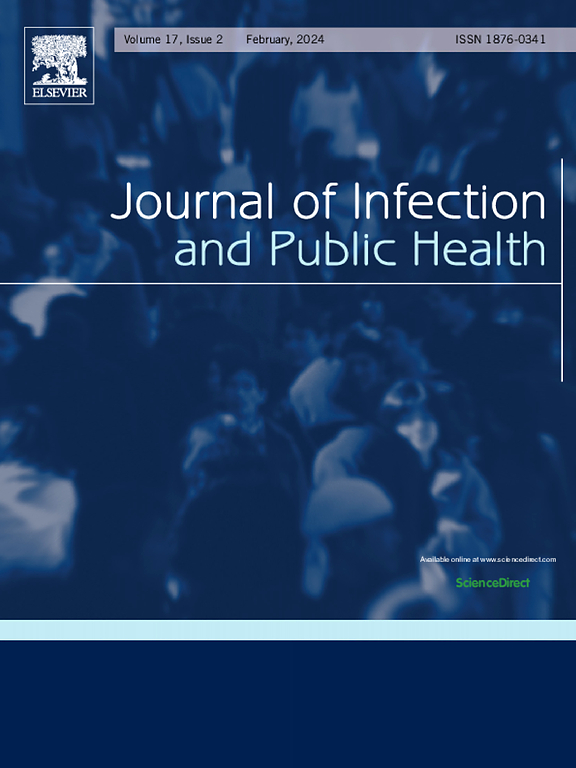A systematic review and meta-analysis of the global prevalence of human enteric adenovirus infections
IF 4.7
3区 医学
Q1 INFECTIOUS DISEASES
引用次数: 0
Abstract
Human adenovirus (HAdV), especially HAdV species F (HAdV-F) is recognized as a cause of acute gastroenteritis (AGE) worldwide. To assess the global prevalence of HAdV in case-patients of all ages with AGE, we conducted a systematic literature search for studies published in English during 2015–2022. We generated pooled prevalence estimates using generalized linear mixed models. Using data from 147 included articles, the overall pooled prevalence among AGE case-patients of any species of HAdV (pan-HAdV) was 5.8 % and 6.0 % for HAdV-F. The prevalence of HAdV was significantly higher among case-patients < 5 years of age compared with case-patients ≥ 5 years of age (pan-HAdV: 6.6 % vs. 2.0 %, p < 0.0001; HAdV-F: 8.7 % vs. 2.3 %, p = 0.04). Prevalence was significantly higher in high mortality developing countries and lowest in developed countries (pan-HAdV: 9.4 % vs. 4.0 %, p < 0.0001; HAdV-F: 11.6 % vs. 3.2 %, p = 0.0003). Understanding the burden of HAdV-associated AGE may be useful for targeted interventions, including future vaccine development.
人类肠道腺病毒感染全球流行率的系统回顾和荟萃分析
人类腺病毒(hav),特别是hav F种(HAdV-F)是世界范围内公认的急性胃肠炎(AGE)的病因。为了评估全球所有年龄AGE患者中hav的流行情况,我们对2015-2022年期间发表的英文研究进行了系统的文献检索。我们使用广义线性混合模型生成了汇总患病率估计。根据纳入的147篇文章的数据,任何种类hav(泛hav)的AGE病例患者的总总患病率为5.8% %,hav - f为6.0 %。与≥ 5岁的病例患者相比,年龄≥ 5岁的病例患者的hav患病率明显更高(pan- hav: 6.6 % vs. 2.0 %,p <; 0.0001;HAdV-F: 8.7 % vs. 2.3 %,p = 0.04)。在高死亡率的发展中国家患病率明显较高,在发达国家患病率最低(pan- hav: 9.4% % vs. 4.0% %,p <; 0.0001;HAdV-F: 11.6 % vs. 3.2 %,p = 0.0003)。了解艾滋病相关AGE的负担可能有助于有针对性的干预措施,包括未来的疫苗开发。
本文章由计算机程序翻译,如有差异,请以英文原文为准。
求助全文
约1分钟内获得全文
求助全文
来源期刊

Journal of Infection and Public Health
PUBLIC, ENVIRONMENTAL & OCCUPATIONAL HEALTH -INFECTIOUS DISEASES
CiteScore
13.10
自引率
1.50%
发文量
203
审稿时长
96 days
期刊介绍:
The Journal of Infection and Public Health, first official journal of the Saudi Arabian Ministry of National Guard Health Affairs, King Saud Bin Abdulaziz University for Health Sciences and the Saudi Association for Public Health, aims to be the foremost scientific, peer-reviewed journal encompassing infection prevention and control, microbiology, infectious diseases, public health and the application of healthcare epidemiology to the evaluation of health outcomes. The point of view of the journal is that infection and public health are closely intertwined and that advances in one area will have positive consequences on the other.
The journal will be useful to all health professionals who are partners in the management of patients with communicable diseases, keeping them up to date. The journal is proud to have an international and diverse editorial board that will assist and facilitate the publication of articles that reflect a global view on infection control and public health, as well as emphasizing our focus on supporting the needs of public health practitioners.
It is our aim to improve healthcare by reducing risk of infection and related adverse outcomes by critical review, selection, and dissemination of new and relevant information in the field of infection control, public health and infectious diseases in all healthcare settings and the community.
 求助内容:
求助内容: 应助结果提醒方式:
应助结果提醒方式:


